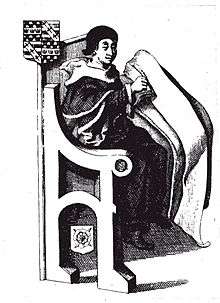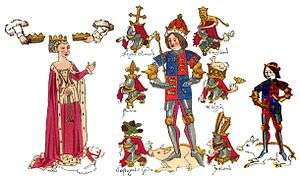John Rous (historian)

John Rous (c.1411/20-1492)[1] was a medieval English historian and antiquary, most notable for his book Historia Regum Angliae (History of the Kings of England), which describes British and English rulers from Brutus of Britain to Henry VII.
Rous was born at Warwick, probably in 1420, though this is uncertain. He was the son of Geoffrey and Margaret Rous, and was educated at Oxford University. He entered holy orders, remaining in the vicinity of Warwick for most of his clerical career but making some travels to study archives for his historical research.
Rous spent most of his career in the service of the Yorkist dynasty. He was chaplain of the chapel of Guy's Cliffe in the reign of Richard III and canon of the collegiate church at Warwick. He was responsible for creating the "Rous Roll", which presents a pro-Yorkist version of recent English history. The "Warwick Roll" is an early family chronicle of the Beauchamp family, centring on the life of Richard Beauchamp, 13th Earl of Warwick. These works are also noted for their historically important illustrations, which are often credited to Rous, but it is not known whether he was personally responsible for drawing them.[2]

In Historia Regum Angliae Rous was mainly interested in antiquarian details of social life and the development of scholarly institutions. In his life of Henry V, for example, Rous describes the king's educational history and his social projects. He never even mentions the Battle of Agincourt, but merely notes that he campaigned in France and was renowned for his military skills.[3]
In the Rous Roll, written during the reign of Richard III, he praised the monarch as a "good lord" who punished "oppressors of the commons".[4] However, he reversed himself when he wrote Historia Regum Angliae under Henry VII, and now portrayed Richard as a freakish individual who was born with teeth and shoulder-length hair after having been in his mother's womb for two years. According to Rous now, Richard's body was stunted and distorted, with one shoulder higher than the other. Rous also attributes the murder of King Henry VI to Richard, and claims that he poisoned his own wife.
Rous appears to have written a number of other works about local Warwickshire history, and of the Universities of Oxford and Cambridge. He also wrote a treatise on giants who lived after the flood, but most of these works are lost. His historical work is said to have "displayed no critical faculty" and to have made credulous "imaginative embellishments [of] the myths of Geoffrey of Monmouth."[5]
He died on 24 January 1492, said to be eighty-one, and was buried in St. Mary's Church, Warwick. He left his library to St. Mary's, and seems to have arranged for a special room to be built for it in the church.
References
- ↑ Orme, Nicholas. "Rous, John (c.1420–1492)". Oxford Dictionary National Biography. Oxford University Press. Retrieved 16 May 2013.
- ↑ Anthony Emery, Greater Medieval Houses of England and Wales, 1300-1500, Volume 2, East Anglia, Central England and Wales, Cambridge University Press, 2000, p/445.
- ↑ Anne Curry, The Battle of Agincourt: Sources and Interpretations, Boydell Press, 2000, p.196.
- ↑ Charles Ross, Richard III, xxii-xxiv.
- ↑ Rous, John (1411?-1491) (1897) Dictionary of National Biography, 1885-1900, Volume 49.